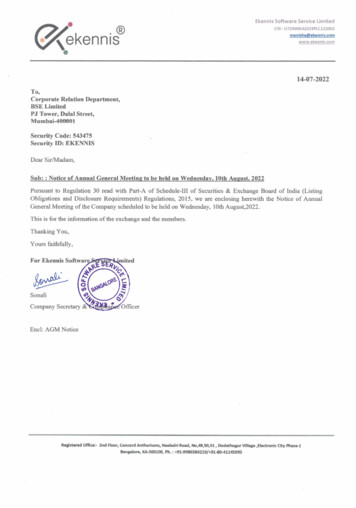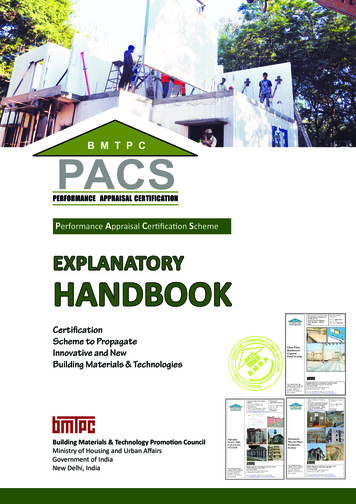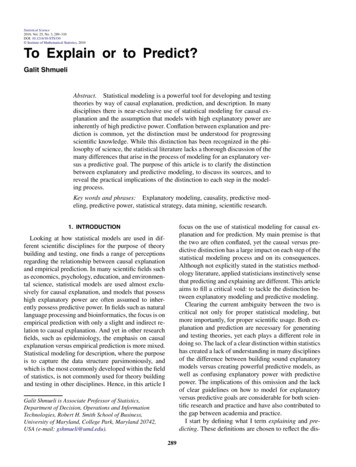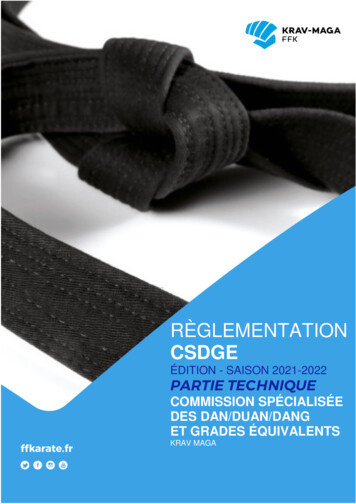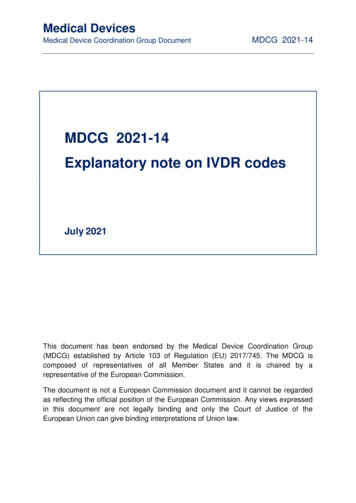
Transcription
Medical DevicesMedical Device Coordination Group DocumentMDCG 2021-14MDCG 2021-14Explanatory note on IVDR codesJuly 2021This document has been endorsed by the Medical Device Coordination Group(MDCG) established by Article 103 of Regulation (EU) 2017/745. The MDCG iscomposed of representatives of all Member States and it is chaired by arepresentative of the European Commission.The document is not a European Commission document and it cannot be regardedas reflecting the official position of the European Commission. Any views expressedin this document are not legally binding and only the Court of Justice of theEuropean Union can give binding interpretations of Union law.
Medical DevicesMedical Device Coordination Group DocumentMDCG 2021-141 IntroductionCommission Implementing Regulation 2017/2185 establishes the codes for the designation of notifiedbodies in medical devices under Regulation (EU) 2017/745 and in vitro diagnostic medical devicesunder Regulation (EU) 2017/746. These codes are primarily used by designating authorities to definethe notified body (NB) scope of designation but they are also used by the NB to:1) describe the individual qualification of the NB’s staff members2) describe the qualification required for assessing a device.It is acknowledged that these codes may be broad, furthermore, unequivocal authorisation ofpersonnel to codes and the assignment of codes to a device may not always be straightforward.However, the NB’s system needs to ensure, in all cases, that the authorisation of personnel andallocation of teams for the conformity assessment of a device ensures adequate knowledge andexpertise.2 ScopeThe lists of codes and corresponding types of in vitro diagnostic medical devices (IVD) established bythe above mentioned Regulation, namely, in its Annex II, takes into account various device typeswhich can be characterised by design and intended purpose including companion diagnosticsdevices, devices for self-testing or for near patient testing, as well as by manufacturing processes andtechnologies used, such as sterilisation.These lists of codes should be used in a way which allows a multi-dimensional application to alltypology of devices. This will ensure that NB as well as the personnel assigned to conformityassessment are fully competent for the devices they are required to assess.This guidance is intended to explain the different levels of codes and how they should be used,including the use of conditions to ensure a harmonised use of the codes especially for the allocationof resources to conformity assessment activities.3 Assignment of codes to IVDs within the conformity assessmentprocedureWhen a manufacturer lodges an application with a NB, the type of devices and technologies subjectto conformity assessment activities are to be indicated. Usually, at the application review stage (asdefined in section 4.3 of Annex VII IVDR), NB will verify the assignment of codes provided by themanufacturer or will assign these codes to the devices themselves. This verification is carried out inorder to ensure that the NB is able to assess the application based on its designation, and that it has
Medical DevicesMDCG 2021-14Medical Device Coordination Group Documentavailable resources to carry out the relevant conformity assessment activities (feasibility evaluation).The final assignment is made by the NB.After this application review, and signing of the contract, the NB will allocate appropriately qualified1and authorised personnel to carry out audit activities or product reviews.The following table presents an overview of the different types of codes and a summary of the maincharacteristics of each of them for the assignment to specific devices and the allocation of resources.Type CodeIVRCodes reflect the designand intended purpose ofthe deviceIVSHorizontal codes thatreflect the specificcharacteristics of thedeviceIVTHorizontal codes thatdescribe technologiesIVPHorizontal codes thatdescribe knowledge inexamination proceduresIVDHorizontal codes thatdescribe knowledge inlaboratory and clinicaldisciplinesAssignment of codes todeviceExactly 1 code per device.*theThe code should be selectedaccording to the order in Regulation2017/2185. If more than 1 IVR codeis applicable, the one that is first inthe list should be selected.0 to several per device.Assign all codes applicable to thedevice.Select once an IVR code has beenassigned.1 to several per deviceAssign the codes which describethe main production technologies.Select once an IVR code has beenassigned.1 to several per device***Assign the codes which describethe main examination procedures.Select once an IVR code has beenassigned.0 to several per deviceAssign the codes which describethe main laboratory and clinicaldisciplines.Relevance for allocation ofconformity assessment teamAllocation of personnel involved iewers) or in audits concerningproduct related aspects.Allocation of personnel involved inthereviewoftechnicaldocumentation.May also be applicable to staffperforming audits concerningcertain special processes.**Allocation of personnel involved inaudits (e.g. site auditors involvedintheauditingofmetalprocessing).Allocation of personnel involved inthereviewoftechnicaldocumentation.Allocation of personnel involved inthereviewoftechnicaldocumentation.Select once an IVR code has beenassigned.* Note: Cases may exist in which more than one IVR code is assigned (please refer to examples 1 and 2, section 3.1)** Note: Assessment of these processes could be performed by product reviewers or site auditors depending on theircompetence and the NB’s system*** Note: Exceptional cases may exist that no IVP code is assigned (e.g. controls or specimen receptacles)1The use of the codes in the sampling of technical documentation can be found in MDCG 2019-13: Guidance on sampling ofMDR Class IIa / Class IIb and IVDR Class B/Class C devices for the assessment of the technical documentation.
Medical DevicesMedical Device Coordination Group Document3.1MDCG 2021-14IVR codesIVR codes reflect the design and intended purpose of the device and hence are mostly relevant forthe allocation of personnel involved in the review of technical documentation. In some specific cases,the NB may assign product reviewers to assess device performance and safety aspects during anaudit. This means that if there are device related issues to be audited and the auditors do not possessthe required qualification, product reviewers who are qualified for the device in question should bepart of the audit team.The NB needs to ensure that the personnel allocated to the project are competent to assess for thedevices and technologies under assessment.The IVR codes may specify a field of in vitro diagnostic medical application (e.g. IVR 0401 Devicesintended to be used in screening/confirmation of congenital/inherited disorders). There are caseswhere more than one specific code might apply to a device. In addition, where there is a broadintended purpose, several codes may apply. Having these issues in mind, the codes were put in ordersuch that the first applicable code in the list is the one to be selected. For example, when codes IVR0201 and IVR 0202 both apply, the IVR 0201 code should be used. This approach ensures consistentassignment of codes (and therefore consistent assignment of suitably qualified staff) to devices.Note that, given the complexity and the diversity of in vitro diagnostic medical devices, in exceptionalcases deviations from the guidance given above may be necessary when assigning codes to devicesin order to ensure suitably qualified staff in the conformity assessment. In such cases, a brief rationaleshall be documented (see Example 1).It is relatively common for IVD devices to be ‘multiplexed’. Such devices are composed of different“components”. In the case of multiplexed devices, it may not be possible to define a main intendedpurpose or main technological principle. In many cases, such equally important components ofmultiplexed assays will still fall under the same code. Nevertheless, in some cases, the componentsof multiplexed assays would not fall under the same IVR code, if they were devices on their own. Asthe components may be considered equally important, a single code, selected from the first applicablecode, cannot be assigned. In such an exceptional case, assignment of several IVR codes can beconsidered, if the properties and risks of the device cannot appropriately be covered with one IVRcode alone, even in conjunction with the relevant IVS, IVT and IVD codes (see Example 2).Therefore, the NB needs to ensure that the assigned staff is qualified to assess all components of thedevice.Example 1: BRCA1 device intended for the detection of deletions or duplications in the humanBRCA1 gene in order to confirm a potential cause and clinical diagnosis for hereditary breastand ovarian cancer and for molecular genetic testing of at-risk family members. According tothe order mentioned above, this IVD falls into IVR 0300 codes. Nevertheless, additionalcompetence regarding genetic testing would still be necessary (IVR 0400 codes). All relevantaspects may not be covered by one IVR code in conjunction with the relevant IVS, IVT, IVPand IVD codes.Example 2: Multiplexed assay for gastrointestinal diseases/symptoms, combining assays forgastrointestinal pathogens with assays for digestive enzymes, immunochemical markers offood intolerances/sensitivities, markers of inflammation, or markers of gastric or coloncancers. This IVD may fall into IVR 0300, IVR 0500 and IVR 0600 codes. Use of several IVRcodes is necessary to cover all aspects.3.2IVS codesIVS codes are horizontal codes that are applicable to devices with specific characteristics. All codesthat are applicable need to be assigned to a device in order to ensure that the review team possessesthe full set of qualifications necessary for the conformity assessment. The IVS codes are primarilyrelevant for the allocation of personnel involved in the review of technical documentation. For some ofthe IVS codes the auditing aspects have their corresponding IVT code for the relevant technology(e.g. IVS 1004 Devices manufactured utilising tissues or cells of human origin, or their derivatives vsIVT 2009 In vitro diagnostic devices manufactured using processing of materials of human, animaland microbial origin). However, IVS codes may also be applicable to staff performing audits
Medical DevicesMDCG 2021-14Medical Device Coordination Group Documentconcerning certain special processes (for example IVS 1005 for staff auditing ethylene oxidesterilisation processes).2Medical device software which are devices in their own right including software apps, software fordata analysis, and for defining or monitoring therapeutic measures should be assigned to code IVS1009 in addition to the applicable IVR code which itself is dependent on the intended use or the fieldof application of the software. In case software is incorporated in a device, used by the device orcontrols the device the code IVS 1010 is relevant. The IVDR requires the definition of specificqualification criteria for personnel allocated to the assessment of software (see IVDR Annex VII,Section 3.2.2, 6th indent).The same principle applies to control materials with quantitative or qualitative assigned valuesintended for one specific analyte or multiple analytes where the code IVS 1007 should be attributed inaddition to the applicable IVR code which itself is dependent on the intended use of the device. Note:The codes IVR 0701 and 0702 are only appropriate for controls without a quantitative or qualitativeassigned value, i.e. no other IVR code higher in the list of IVR codes can be selected.Code IVS 1008 (instruments, equipment, systems or apparatus) should be used if the IVD contains, ispart of or is integrated into instruments, equipment, systems or apparatus. Note: The code IVR 0802only applies in case of separate sterile instruments of class A intended by the manufacturerspecifically to be used for in vitro diagnostic procedures.Example: A blood glucose meter: An apparatus used for self-patient testing that contains anincorporated software to measure the glucose levels in the bloodstream will need to beassigned to the following IVS codes:1) IVS 1002 - Devices intended to be used for self-testing, because it is to be used directly bythe end user,2) IVS 1008 - Instruments, equipment, systems or apparatus, because it is an apparatus initself,3) IVS 1010 - Devices incorporating software/utilising software/controlled by software,because it contains software.3.3IVT codesIVT codes relate to the technologies that are used in the manufacturing and making available of thedevices. IVT codes are most relevant for the allocation of site auditors.Assignment of IVT codes should be done taking into consideration the production of the device itself,in addition to critical upstream production steps. This means that, even though many codes could beapplicable when taking into consideration the technologies/processes involved in the entire supplychain, related to manufacture, of a medical device, only those for the critical technologies/productionsteps should be considered.Example: An Immunoassay where the manufacturing involves antibody production,purification and immobilisation in a clean room/controlled environment should be assigned toat least the following IVT codes:1) IVT 2005 - In vitro diagnostic devices manufactured using biotechnology and2) IVT 2008 - In vitro diagnostic devices manufactured in clean rooms and associatedcontrolled environments.Note that, despite the fact that the manufacturer itself may not physically manufacture all parts of thedevice, the IVT codes concerning the manufacturing steps are assigned to the device since they arerelevant when auditing suppliers / subcontractors.2Guidance on Qualification and Classification of Software in Regulation (EU) 2017/745 – MDR and Regulation (EU) 2017/746– IVDR
Medical DevicesMedical Device Coordination Group Document3.4MDCG 2021-14IVP codesIVP codes relate to the knowledge in examination procedures for the purpose of product verification.IVP codes are primarily used for the allocation of product reviewers.Example 1: Microorganism identification using latex agglutination beads to detect specificmicroorganism antigens. IVP 3001: In vitro diagnostic devices which require knowledgeregarding agglutination testsExample 2: Immune cell phenotyping (e.g. to determine acute myeloid leukaemia) by flowcytometry. IVP 3006: In vitro diagnostic devices which require knowledge regarding flowcytometryExample 3: Electrolyte quantification using ion-selective electrodes. IVP 3012: In vitrodiagnostic devices which require knowledge regarding physical chemistry includingelectrochemistryExample 4: Microorganism identification using mass spectrometry IVP 3012: In vitrodiagnostic devices which require knowledge regarding physical chemistry includingelectrochemistryExample 5: Colorimetric assay for the quantification of creatinine.1) IVP 3002: In vitro diagnostic devices which require knowledge regarding biochemistryand2) IVP 3013: In vitro diagnostic devices which require knowledge regarding spectroscopy3.5IVD codesIVD codes relate to the knowledge in laboratory and clinical disciplines for the purpose of the productverification. IVD codes are relevant for the allocation of product reviewers.The IVD codes listed in Commission Implementing Regulation 2017/2185 (IVD 4001 to 4012) refer tolaboratory and clinical disciplines like bacteriology, clinical chemistry/biochemistry or immunologywhich specifically deal with or use the IVD in question. In addition, it may be necessary to involveexperts of other clinical disciplines not listed in Commission Implementing Regulation 2017/2185 inwhich a disease or disorder to be detected with the IVD in question is treated (clinical specialists, seealso e.g. IVDR Annex IX, 4.4). This may be the case, for example, when a marker for a disease isnewly established by a manufacturer and the relevance of this marker for the underlying disease hasto be assessed. Examples of these clinical disciplines may be cardiology or oncology.4 Competence description: conditions (including limitations)Conditions should be established by the NB for individual codes in cases where the qualification ofthe staff authorised to a certain code is not sufficient to cover the entire spectrum of the devices withinthis code. The designating authority could also apply conditions to the NB's designation where theNB does not have sufficient competence to cover a given code or could seek designation forconformity assessment of only certain devices within a code.Conditions, including limitations, should be formulated in an unambiguous way. Furthermore, sincethe technical codes mirror the competence system of the NB, the conditions and limitations shouldconcern device characteristics. The experience and competence of the NB may for example belimited due to the range of devices assessed under the IVDD. The limitations are applicable to alltypes of codes. Here, the focus is on examples of IVR codes as they serve as the basis of thetechnical documentation assessment.Example 1: IVR 0301: Devices intended to be used in screening, diagnosis, staging ormonitoring of cancer. In cases where the experience is solely based on assessing devices forPSA, an appropriate condition could be including only PSA.
Medical DevicesMedical Device Coordination Group DocumentMDCG 2021-14Example 2: IVR 0401: Devices intended to be used in screening/confirmation ofcongenital/inherited disorders. In cases where the experience is solely based on assessingdevices for T21 risk, an appropriate condition could be including only devices for T21 risk.Example 3: IVR 0505: Devices intended to be used to grow/isolate/identify and handleinfectious agents. In cases where the full code cannot be covered due to lack of experiencein, for example, growing and isolating viruses, a suitable condition could be either to: limit the scope to devices intended to identify infectious agents exclusion of devices intended for growing and isolating viruses.Further examples of conditions are illustrated in the final column of the table below. Considerations ofthe conditions should be based on the demonstrated competence of the applicant body.
Medical DevicesMDCG 2021-14Medical Device Coordination Group Document5 Specific clarifications linked to individual codesDevices intended to be used to determine markers ofthe specific blood grouping systems to ensure theimmunological compatibility of blood, bloodcomponents, cells, tissue or organs that areintended for transfusion or transplantation or celladministrationDevices covered and Specific ConsiderationsIVR 0101Devices intended to determine markers of the ABO system [A(ABO1), B (ABO2), AB (ABO3)]ABO typing, cross matching and identifying antibodies against ABO antigenslistedIVR 0102Devices intended to determine markers of the Rhesus system[RH1 (D), RHW1, RH2 (C), RH3 (E), RH4 (c), RH5 (e)]Rhesus typing, cross matching and identifying antibodies against Rhesusantigens listedIVR 0103Devices intended to determine markers of the Kell system[Kel1 (K)]Kell typing, cross matching and identifying antibodies against Kell antigenslistedIVR 0104Devices intended to determine markers of the Kidd system[JK1 (Jka), JK2 (Jkb)]Kidd typing, cross matching and identifying antibodies against Kidd antigenslistedIVR 0105Devices intended to determine markers of the Duffy system[FY1 (Fya), FY2 (Fyb)]Duffy typing, cross matching and identifying antibodies against Duffy antigenslistedIVRCODE12Examples ofconditionsOther devices intended to be used for bloodgroupingIVR 0106Other devices intended to be used for blood groupingDevices intended for other blood groups [e.g. MNS, Lewis, Anti-humanglobulin (Coombs serum)]1The devices included in this column are only some examples of the devices covered in the relevant code. This column is not intended to provide an exhaustive list of devices included in each code.The intended purpose of each device needs to be carefully considered in the application of the codes.2The assessment should also consider Section 5.1 of Annex IX as well as validation of SSP acc. Article 29.
Medical DevicesMedical Device Coordination Group DocumentMDCG 2021-14Devices intended to be used for tissue typingIVR 0201Devices intended to be used for tissue typing (HLA A, B, DR)to ensure the immunological compatibility of blood, bloodcomponents, cells, tissue or organs that are intended fortransfusion or transplantation or cell administrationDevices for typing, cross matching, identifying antibodies against listed HLAmarkers, relevant software, genetic screening and HLA CDC cross matchingIVR 0202Other devices intended to be used for tissue typingOther devices for tissue typing, other HLA markers [e.g. HLA C, DPA1,DPB1, DQB1, Human Neutrophil Antigen (HNA)]Devices intended to be used for markers of cancerand non-malignant tumours except devices forhuman genetic testingIVR 0301Devices intended to be used in screening, diagnosis, staging ormonitoring of cancerIVR 0302Other devices intended to be used for markers of cancer andnon-malignant tumoursImmunoassays for cancer associated antigens (CA 12-5, CA 15-3, CA 19-9,CEA, HE4, PSA)Faecal occult blood screening test (FOBT) and faecal immuno-chemical test(FIT)Image analysis algorithms related to detection and/or quantitation of cancermarkersDevice intended for BRCA1 genetic testing of tumour tissue to confirm apotential cause and clinical diagnosis for hereditary breast and ovariancancer and for molecular genetic testing of at-risk family membersCompanion diagnostic device for detection of somatic mutations in codons12, 13 and 61 of the KRAS gene in human colorectal cancer (CRC) tumourtissue for determining eligibility for cetuximab or panitumumab treatment,devices (monoclonal antibodies) intended for the characterisation ofhematologic neoplasiaLimit only toPSA deviceswhere theexperience issolely based onassessingdevices forPSA (seesection 4)Devices intended to be used for human genetictestingIVR 0401Devices intended to be used in screening / confirmation ofcongenital / inherited disordersDevices intended for prenatal screening for trisomy 13, 18, and 21; andrelated softwareGenetic test for mutations in NPC1 and NPC2 genes for diagnosis ofNiemann–Pick disease, type CNGS test panel and related software for diagnosis of amyotrophic lateralIn cases wherethe experienceis solely basedon assessingdevices for T21
Medical DevicesMedical Device Coordination Group DocumentMDCG 2021-14sclerosis (ALS)IVR 0402Devices intended to be used to predict geneticdisease/disorder risk and prognosisIVR 0403Other devices intended to be used for human genetic testingGenetic testing for Cystic Fibrosis carriersGenetic testing for Alzheimer's and Parkinson’s predictors (risk score)Genetic testing for diabetes and cardiovascular disease prognosis (riskscores)Software for calculating polygenic risk scoresWhole exome sequencing for suspected genetic disorders where a specificgenetic test is not availablePharmacogenomic testing for genes for CYP liver enzymes CYP2C9 andCYP2C19Devices intended to be used for the screening,confirmation, identification of infectious agents ordetermination of immune statusIVR 0501Devices intended to be used for pre-natal screening of womenin order to determine their immune status towardstransmissible agentsTORCH diagnostic: Antibodies (IgG, IgM) against rubella, toxoplasmaGondii, cytomegalovirus, herpes simplexExclusion of molecular biology based devices or antigen detection devices asthey detect the transmissible agent itself and not the antibodies against itIVR 0502Devices intended to be used to detect the presence of, orexposure to transmissible agents in blood, blood components,cells, tissues or organs, or in any of their derivatives, to assesstheir suitability for transfusion, transplantation or celladministrationDetection of viruses, bacteria, parasites or non-conventional infectiousagents (e.g. vCJD)Immunological (detection of Ab and/or Ag) and molecular biology assaysIVR 0503Devices intended to be used to detect the presence of, orexposure to an infectious agent including sexually transmittedagentsTests for any infectious agent (bacteria, fungi, parasites, mycobacteria,viruses) using all possible direct and indirect methods (e.g. immunologicalassays, molecular biology assays, staining, histological assays)risk, anappropriatecondition couldbe includingonly devices forT21 risk (seesection 4)
Medical DevicesMedical Device Coordination Group DocumentIVR 0504Devices intended to be used to determine the infectious load,to determine infective disease status or immune status anddevices used for infectious disease stagingIVR 0505Devices intended to be used to grow / isolate / identify andhandle infectious agentsIVR 0506Other devices intended to be used to determine markers ofinfections / immune statusMDCG 2021-14NAT for measuring viral load for HIV, measurement of tetanus Ab (protectivelevel against tetanus)Including antigenic assays if they are quantitativeDevices used to identify and enumerate TBNK cells (CD4) for monitoringsome forms of immune deficiency and autoimmune disease and to monitorHIV individualsAgar plate, liquid culture media, preservation media, minimal inhibitionconcentration (MIC) testsNon-specific markers of sepsis (e.g. C-reactive protein, procalcitonin)Devices intended to be used for a specific diseaseIVR 0601Devices intended to be used for screening / confirmation ofspecific disorders / impairmentsDevices for exploration of kidney disorder or liver injuryIVR 0602Devices intended to be used for screening, determination ormonitoring of physiological markers for a specific diseaseMeasurement of clotting factors for specific diseases (e.g. von Willebrandfactor, factor VIII for haemophilia A), haemoglobin A1c for diabetesmonitoringIVR 0603Devices intended to be used for screening, confirmation /determination, or monitoring of allergies and intolerancesIgE specific immunoassays, IgA anti-transglutaminase (coeliac disease)IVR 0604Other devices intended to be used for a specific diseaseOther devices not falling into the codes aboveA suitablecondition couldbe either to:limit the scopeto devicesintended toidentifyinfectiousagents,exclusion ofdevicesintended forgrowing andisolating viruses(see section 4).
Medical DevicesMedical Device Coordination Group DocumentMDCG 2021-14Devices intended to be used to define or monitorphysiological status and therapeutic measuresIVR 0605Devices intended to be used for monitoring of levels ofmedicinal products, substances or biological componentsMedicinal product, or poison toxic products measurement or detection inblood (e.g lithium, warfarin, valproïc acid) or in urine (e.g. benzodiazepin)IVR 0606Devices intended to be used for non-infectious disease stagingCholesterol, hormone measurement (estradiol progesterone, TSH,aldosterone)IVR 0607Devices intended to be used for detection of pregnancy orfertility testingHCG, LH, estradiol (depending of the intended use)IVR 0608Devices intended to be used for screening, determination ormonitoring of physiological markersUrine or blood markers: magnesium, potassium, coagulation rate, INR,partial thromboplastin time (PTT), platelet count, plateletIVR 0609Other devices intended to be used to define or monitorphysiological status and therapeutic measuresOther devices not falling into the codes aboveControls without a quantitative or qualitativeassigned valueIVR 0701Devices which are controls without a quantitative assignedvalueIVR 0702Devices which are controls without a qualitative assigned valueClass A devices in sterile conditionAny IVD controls that are qualitative (e.g. control materials for detection ofpathogens)Any IVD controls that do not fall under IVR 0701 (e.g. QC material as aheterozygous quality control to monitor analytical performance of theextraction, amplification and detection)A DNA or RNA probe supplied for use as a non-assay specific normal controlfor in situ hybridisation (ISH)
Medical DevicesMedical Device Coordination Group DocumentIVR 0801IVR 0802IVR 0803Devices referred to in point 2.5 (rule 5), under a), of Annex VIIIto Regulation (EU) 2017/746Instruments intended specifically to be used for in vitrodiagnostic procedures referred to in point 2.5 (rule 5), under b),of Annex VIII to Regulation (EU) 2017/746Specimen receptacles referred to in point 2.5 (rule 5), under c),of Annex VIII to Regulation (EU) 2017/746MDCG 2021-14Products for general laboratory use, accessories which possess no criticalcharacteristics, buffer solutions, washing solutions, and general culturemedia and histological stains, intended by the manufacturer to make themsuitable for in vitro diagnostic procedures relating to a specific examination(e.g. kits for isolation and purification of nucleic acids from humanspecimens, sterile buffer solutions, lysing solutions and diluents specified foruse with an IVD)Sterile instruments intended by the manufacturer specifically to be used for invitro diagnostic proceduresSpecimen receptacles for e.g. blood, urine
Medical DevicesMedical Device Coordination Group DocumentMDCG 2021-14IVSCODEIn vitro diagnostic devices with specificcharacteristicsDevices covered and Specific ConsiderationsIVS 1001Devices intended to be used for near-patient testingTroponin tests used in emergency room, blood glucose meter, bloodgrouping devices used for pre-transfusion controlDepending on the intended use, devices may be classified into IVS 1001 or1002 or both. Also depending on national regulationsIVS 1002Devices intended to be used for self-testingPregnancy and fertility self-tests, HIV self-test, blood glucose metersIVS 1003Devices intended to be used as compan
cancers. This IVD may fall into IVR 0300, IVR 0500 and IVR 0600 codes. Use of several IVR codes is necessary to cover all aspects. 3.2 IVS codes IVS codes are horizontal codes that are applicable to devices with specific characteristics. All codes that are applicable need to be assigned to a device in order to ensure that the review team possesses



